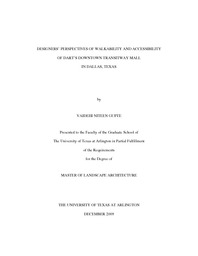| dc.description.abstract | Providing quality urban spaces including plazas and pedestrian malls encourages use of the Central Business District (CBD) and stimulates a vibrant atmosphere for casual strolling, window shopping, and browsing (Rubenstein, 1992). Dallas, Texas, which in many people's minds defines the term `automobile city', has developed and implemented a visionary plan since the early 1990s' for using light rail as a tool for economic growth and community development. Thus, Dallas Area Rapid Transit's (DART's) starter system of light rail opened in June 1996, and a city that grew up with the automobile embraced transit as an integral part of its future (Garrick, 2000). Also in 1996, the DART developed a downtown transitway mall within the CBD to enhance the economic vitality and aesthetics of the area. The transitway mall was designed to re-energize downtown Dallas as a center where people work, reside or come for recreational, cultural and shopping purposes. Since the implementation of the transitway mall, a very limited number of studies address the design of the mall as a pedestrian district (NCTCOG, 2003). The objective of this research is to evaluate design elements of the downtown transitway mall and study their impacts on walkability and accessibility within the mall. The research began with a comprehensive literature review to determine the design elements which affect the walkability and accessibility of the urban environment. A combination of passive observation techniques, walkthrough surveys with design professionals, and analysis of the Regional Mobility Initiatives data (NCTCOG- North Central Texas Council of Government, 2003) were utilized to evaluate the walkability and accessibility of the transitway mall. The findings from these three methods were analyzed using data triangulation. Results of the study indicate that certain design elements impact the walkability and accessibility of the transitway mall. This research identifies the key design elements of the transitway mall that impact the accessibility and the walking experience of pedestrians within the mall. This research can guide landscape architects, and other design professionals, in their future design projects to create walkable and accessible urban spaces for pedestrians. | en_US |

